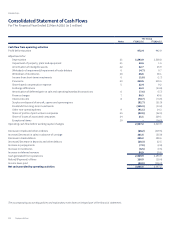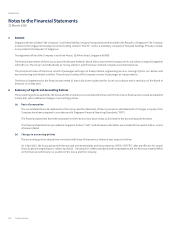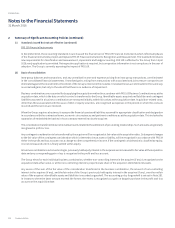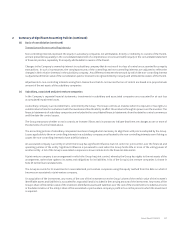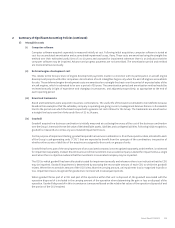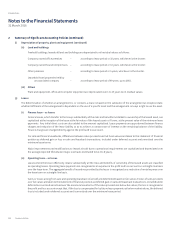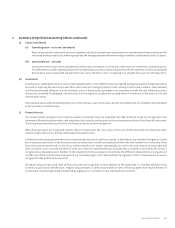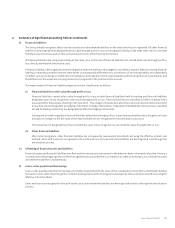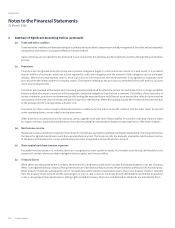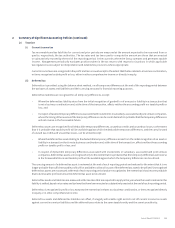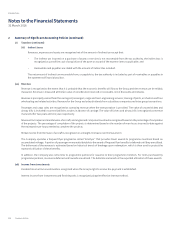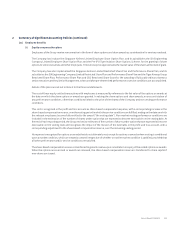Singapore Airlines 2016 Annual Report Download - page 123
Download and view the complete annual report
Please find page 123 of the 2016 Singapore Airlines annual report below. You can navigate through the pages in the report by either clicking on the pages listed below, or by using the keyword search tool below to find specific information within the annual report.2 Summary of Significant Accounting Policies (continued)
(h) Property, plant and equipment
All items of property, plant and equipment are initially recorded at cost. Subsequent to recognition, property, plant and equipment
are stated at cost less accumulated depreciation and accumulated impairment losses, if any. The cost of an item of property, plant and
equipment is recognised as an asset if, and only if, it is probable that future economic benefits associated with the item will flow to the
Group and the cost of the item can be measured reliably.
The cost of an item of property, plant and equipment comprises its purchase price and any directly attributable costs of bringing the asset
to working condition for its intended use. The cost of aircra is stated net of manufacturers’ credit. Aircra and related equipment acquired
on an exchange basis are stated at amounts paid plus the fair value of the fixed asset traded-in. Expenditure for heavy maintenance visits
on aircra, engine overhauls and landing gear overhauls, is capitalised at cost. Expenditure for engine overhaul costs covered by power-
by-hour (fixed rate charged per hour) maintenance agreements is recorded as advance payment and capitalised upon completion of an
overhaul. Expenditure for other maintenance and repairs is charged to the profit and loss account. When assets are sold or retired, their
costs, accumulated depreciation and accumulated impairment losses, if any, are removed from the financial statements and any gain or
loss resulting from their disposal is included in the profit and loss account.
Leasehold hotel properties held by an associated company are carried at fair value, less accumulated depreciation and accumulated
impairment losses. Fair values of leasehold hotel properties are determined by independent professional valuers on an annual basis. The
Group’s share of the revaluation gain or loss is reflected under the share of post-acquisition capital reserve.
(i) Depreciation of property, plant and equipment
Property, plant and equipment are depreciated on a straight-line basis at rates which are calculated to write down their cost to their
estimated residual values at the end of their operational lives. Operational lives, residual values and depreciation method are reviewed
annually in the light of experience and changing circumstances, and adjusted prospectively, if appropriate. Significant components of
individual assets are assessed and if a component has a useful life that is dierent from the remainder of that asset, that component
is depreciated separately. Depreciation is recognised from the date the property, plant and equipment are installed and ready for use.
Freehold land, advance and progress payments are not depreciated.
Fully depreciated assets are retained in the financial statements until they are no longer in use. No depreciation is charged aer assets
are depreciated to their residual values.
(i) Aircra, spares and spare engines
The Group depreciates its new passenger aircra, spares and spare engines over 15 to 20 years to 5% to 10% residual values.
The Group depreciates its new freighter aircra over 20 years to 5% residual values. For used freighter aircra, the Group depreciates
them over the remaining life (20 years less age of aircra) to 5% residual values.
Major inspection costs relating to landing gear overhauls, heavy maintenance visits and engine overhauls (including inspection
costs provided under power-by-hour maintenance agreements) are capitalised and depreciated over the average expected life
between major overhauls, estimated to be 4 to 10 years.
Training aircra are depreciated over 5 to 15 years to 10% to 20% residual values.
Flight simulators are depreciated over 5 to 10 years to nil residual values.
Annual Report FY2015/16 121



